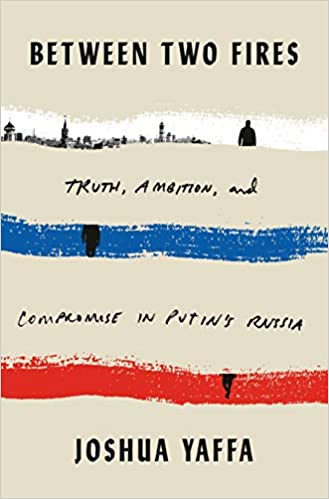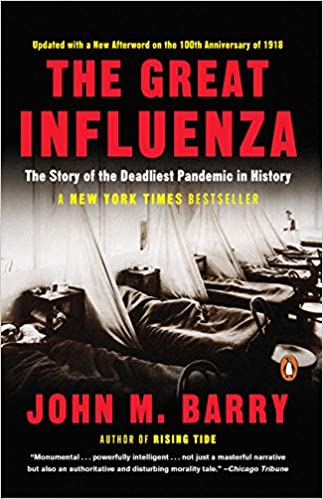Between Two Fires: Truth, Ambition, and Compromise in Putin’s
by Joshua Yaffa
Yaffa’s immersing book is a fascinating look at how Russian citizens manage to live within their totalitarian government and give Putin an 81% approval rating. Without the approval of the government, Russians have no opportunity to realize their desires. The Soviet authorities have complete control over the media, business, and religion. Consequently many Russians determine they must make compromises in order to succeed in their careers. Investigative journalist Yaffa, adeptly examines how they compromise and justify their decisions. Putin cleverly realized the importance of appearing to be magnanimous and adaptable by permitting its citizens leeway regarding the State’s policies as long as they don’t overtly criticize it. This creates many opportunities to compromise, while appearing to cooperate with the State, and contributes to the continuation of the repressive government.
The book opens with a brief biography of sociologist Yuri Levada. He wrote about “the wily man” who he believed represented the Russian people. The “wily man” not only tolerates deception, but is willing to be deceived, and even requires self-deception for the sake of his own self-preservation.” He adapts to social reality, looking for oversights and gaps in the ruling system and ways to circumvent them. Yaffa introduces readers to several Russians who compromise successfully, some not. Heda Saratova “is a human rights activist who worked for years to rescue victims of persecution and torture in Chechnya. She built her career as an official of Memorial, which is the organization that fights to tell the truth about atrocities from the Stalinist 1930s to the present day.”
She decided to refrain from criticizing certain powerful people in order to save people’s lives. “She said it was not a perfect solution but better than not doing anything”. Then there is one of Russia’s most valued propagandists, Konstantin Ernst, manager of Channel One, a Russian television network. Ernst’s aim is to have ” conventional TV shows that keep a large portion of viewers tuned in and pacified.” He rose to fame by compromising his moral values (not that he is the only person to ever do so). He believes “truth is a subjective concept, a matter of one’s allegiances and biases and parochial interests,” and enjoys the high “to be able to influence many millions of people.”
The Perfect Predator : A Scientist’s Race To Save Her Husband From A Deadly Superbug
by Steffanie Strathdee and Thomas Patterson
A gripping love story and medical thriller, this incredibly riveting account is about what love and determination can do. It’s the true story of two intrepid scientists, infectious disease epidemiologist Steffanie Strathdee, Ph.D. and her husband, a Distinguished Professor of Psychiatry at UC San Diego, Tom Patterson Ph.D. Global travelers, they were exploring the wonders of Egypt when Tom became seriously ill. No stranger to exotic illnesses, they always carried Cipro, a heavy weight antibiotic, with them to combat any “bugs” they caught. The Luxor medical clinic was ill-equipped to handle the seriousness of Tom’s harrowing illness so he was medvac’d to a world class medical center in Germany. From there he was evacuated to an equally renown medical center, University of California , San Diego School of Medicine, for further treatment , where Steffanie and Tom worked. The medical staff discovered why Tom was not improving : he was infected with one of the deadliest antibiotic resistant bacteria in the world, Acinetbacter baumannii. This intriguing book recounts how Steffanie relentlessly researched and contacted scientists all over the globe, including researchers at Texas A&M, and the Naval Research and Development Biomedical Center. Both institutions played instrumental roles in Tom’s recovery.
Over 100 years ago, phage viruses had been considered as a possible “perfect predator” against bacteria. However they were ignored in favor of antibiotics. Because Tom’s bacteria was resistant to antibiotics, the experimental phage treatment was proposed as a potential treatment. The collaboration, resourcefulness, and tenacity among the champion medical team while caring for Tom was impressive & inspiring. A “page turner,” I’m confident you’ll find this an engrossing read.
Regretting her former cavalier attitude about antibiotics, Steffanie also discusses the history of antibiotics and the overuse that’s caused the devastating antibiotic resistance today.
Both Tom and Steffanie worked as HIV researchers for over a decade. Steffanie is Associate Dean of Global Health Sciences and Professor and Harold Simon Chair at the University of California, San Diego. She also directs the UC San Diego Center for Innovative Phage Application and Therapeutics and is an Adjunct Professor at Johns Hopkins and Simon Fraser Universities. She was named one of TIME’s 50 Most Influential People in Health Care.
The Great Influenza: The Story of the Deadliest Pandemic in History
by John M. Barry
Barry chronicles the history of medical science in the beginning of the book, being cognizant of its historical context. He describes the pandemic, how it spread, the challenges, contributions made by eminent scientists of the day, and detailed information regarding viruses. Barry warns of future pandemics and notes the world is not prepared to combat them.
The Great Influenza pandemic occurred from 1918 to 1920, during World War I. The countries involved in the war didn’t want to cause additional panic to the public during the war, so reporting on the flu was censored. Spain remained a neutral country and openly discussed and reported on the virus. Thus the pandemic became known as the “Spanish Flu,” a misnomer.
According to the CDC, “it is estimated that about 500 million people or one-third of the world’s population became infected with this virus. The number of deaths was estimated to be at least 50 million worldwide with about 675,000 occurring in the United States.”
Although the author is a historian and not a scientist, he conducted immense research for seven years while writing this outstanding book. It’s a remarkable read, and am glad I read it. I learned a great deal, although it was eerie, as I compared the 1918 Great Influenza and the current Covid-19 pandemic’s similarities.
Two interesting facts are: Gunnison, Colorado escaped the flu because of a total quarantine, and as a result of the 1918 pandemic, the New Mexico Department of Public Health was created. Also, The Perfect Predator and The Great Influenza books complemented each other in many ways regarding science and disease.



